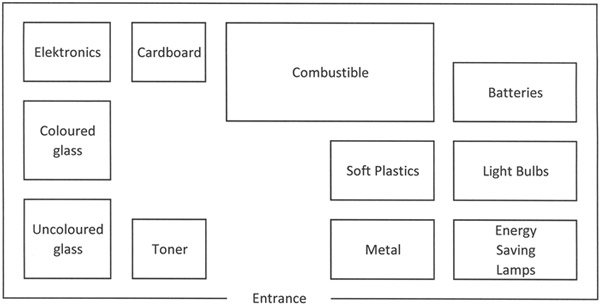Waste handling at CBH Campus Solna – Environmental Physiology
PROCEDURE
Decisionmaker: Head of School
Valid from: 7 October 2019
Changed from: 7 Ocotber 2019
Reference number: C-2019-0873
Responsible for review and questions: Infrastructure Manager
1. Purpose
To describe how to handle waste in accordance with applicable rules and legal requirements.
2. Scope
The procedure for waste handling covers all areas used by CBH in the Physiology building at Berzelius väg 13. The waste disposal at KTH Environmental Physiology is handled according to the rules, regulations and agreements of Karolinska Institutet (KI).
This document describes the basic waste disposal routines, detailed information regarding how chemical/hazardous waste should be handled is found in routine “How to handle chemical waste including hazardous waste at CBH campus Solna - Environmental Physiology MR-CBH-010 v01”.
3. Definitions
Waste – All fractions of waste except hazardous waste.
4. Responsibilities
The Head of School – has the overall responsibility for waste being handled in a correct way at the School.
All employees – are responsible for sorting their waste into the fractions available locally.
5. Procedure
Different types of waste are thrown according to:
Paper waste
Copying paper, newspaper etc. is thrown into boxes in the offices. The boxes are emptied in a special white container on the office floor. When full, the container is placed on the loading platform outside the entrance Tuesday mornings.
Household waste
Waste from the kitchen, toilets, at the fruit basket and the coffee machine is handled daily by the cleaning company.
Corrugated board/cardboard/carton
Must be left in thewire cage where corrugated board/carton is to be collected in the recycling room. The packaging should be taken apart and folded together and must not be placed so that they end up outside the cage.
Glass waste
Must be left in the designated containers, colored and non- colored glass, in the recycling room. Bottles must not contain any residues of solvents or other chemicals.
Packaging made of metal
Must be left in the designated container in the recycling room.
Package made of plastic
There is containers for soft plastic in the recycling room. Styrofoam must be left in the container for combustible waste.
Batteries
Must be left in the designated container in the recycling room.
Electronics waste
Must be left in thedesignated container in the recycling room.
Fluorescent lamp and other bulbs
Must be left in the designated container in the recycling room.
Toner cartridges
For printers and copiers must be left in the designated container in the recycling room.
General waste
There is large containers for combustible items in the recycling room.
Other office garbage
Is thrown in the garbage bin in the office and emptied by the cleaning company every week. Larger items must be left in the designated container in the recycling room.
The recycling room is located outside the entrance at the loading platform.

Figure 1: Layout of recycling room. Containers to the left: toner, uncoloured glass, coloured glass, electronics, cardboard. Containers to the right: combustible, soft plastics, metal, batteries, light bulbs, energy saving lamps.
There is a detailed sorting guide on KI's intranet: Sorting guide .
6. Attachments
7. Amendments
| Approved version | Document Date | Amendment | Name |
|---|---|---|---|
| 01 | 2018-04-03 | New routine | Björn Johannesson |
| 02 | 2019-04-15 | Routine moved to a new format. No changes in content. This document replaces MR-CBH-011 | Sara Pettersson |
